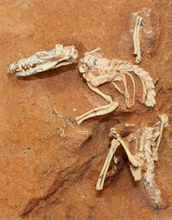Multimedia Gallery
Placental mammal diversity came after dinosaurs (Image 1)
The fossil bones of Ukhaatherium nessovi, a shrew-sized, Cretaceous-age animal uncovered in the Gobi Desert and used in a recent mammal tree-of-life study.
When it was discovered in 1994 by the Mongolian Academy and the American Museum of Natural History, the remarkably well-preserved skeleton of this small creature showed the presence of epipubic bones, attached to both sides of the pubis. In living mammals, these bones occur only in marsupials (mammals like kangaroos that often develop their young in pouches) and monotremes (mammals like platypuses, which lay eggs), but their presence in U. nessovi showed that a close relative of recent placental mammals that lived many millions of years ago also had these bones.
In published research results, the scientists revealed that, contrary to a commonly held theory, placental mammals did not diversify into their present-day lineages until after the extinction event that eliminated non-avian dinosaurs and about 70 percent of all species on Earth, some 65 million years ago.
"Molecular clock estimates and the fossil record do not agree on the time of origin and diversification of many modern and extinct biotic groups," said H. Richard Lane, a program director in the National Science Foundation's (NSF) Division of Earth Sciences, which co-funded the research with NSF's Division of Environmental Biology. "Data from the NSF-supported Assembling the Tree of Life initiative have been the key to these conclusions."
These findings are the result of a multi-year collaborative project funded by NSF's Assembling the Tree of Life initiative. To read more about this research, see NSF press release Placental Mammal Diversity Blossomed After Age of Dinosaurs. [Research supported by NSF grants DBI 07-43309, EAR 08-27993, DEB 06-29959, DEB 06-29836, and DEB 06-29811.] (Date of Image: 2012) [See related image Here.]
Credit: AMNH/S. Goldberg, M. Novacek
Images and other media in the National Science Foundation Multimedia Gallery are available for use in print and electronic material by NSF employees, members of the media, university staff, teachers and the general public. All media in the gallery are intended for personal, educational and nonprofit/non-commercial use only.
Images credited to the National Science Foundation, a federal agency, are in the public domain. The images were created by employees of the United States Government as part of their official duties or prepared by contractors as "works for hire" for NSF. You may freely use NSF-credited images and, at your discretion, credit NSF with a "Courtesy: National Science Foundation" notation.
Additional information about general usage can be found in Conditions.
Also Available:
Download the high-resolution JPG version of the image. (3.2 MB)
Use your mouse to right-click (Mac users may need to Ctrl-click) the link above and choose the option that will save the file or target to your computer.



